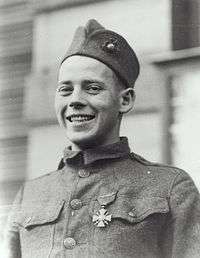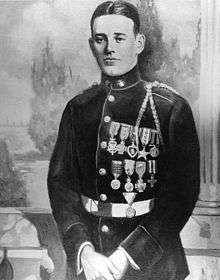John J. Kelly
| John Joseph Kelly | |
|---|---|
  Recipient of the Army and Navy Medals of Honor | |
| Born |
June 24, 1898 Chicago, Illinois |
| Died |
November 20, 1957 (aged 59) Chicago, Illinois |
| Allegiance |
|
| Service/branch |
|
| Years of service | 1917–19 |
| Rank | Private |
| Unit | 6th Regiment, 2nd Division |
| Battles/wars |
World War I Battle of Château-Thierry Battle of Saint-Mihiel Battle of Blanc Mont Ridge |
| Awards |
Medal of Honor (Army & Navy) Purple Heart Silver Star (4) Médaille militaire Croix de guerre Croce al Merito di Guerra |
John Joseph Kelly (June 24, 1898 – November 20, 1957) was a United States Marine who was awarded both the Army and Navy Medals of Honor[1] for his heroic actions on October 13, 1918 at the Battle of Blanc Mont Ridge, France during World War I. He was the last surviving of 19 two-time Medal of Honor recipients when he died.
Biography
Kelly was born in Chicago, Illinois on June 24, 1898. He enlisted as a private in the United States Marine Corps on May 15, 1917 in Port Royal, South Carolina. On September 5, 1917, he joined the 7th Company, 6th Regiment, at Quantico, Virginia, and on September 12, 1917, he was transferred to the 78th Company. On January 19, 1918, his regiment embarked from Philadelphia, Pennsylvania on the USS Henderson and arrived at St. Nazaire, France on February 5, 1918.
Private Kelly participated in engagements at Château-Thierry, St. Mihiel, Blanc Mont and the Meuse-Argonne offensive. In the desperate fighting at Blanc Mont Ridge he ran "100 yards in advance of the front line and attacked an enemy machine-gun nest", for which he was awarded both the Army and Navy Medals of Honor.
He also participated in the march to the Rhine River and in the occupation of the Coblenz Bridgehead, from November 17, to December 12, 1918. Pvt Kelly was honorably discharged, with character "Excellent" at the Marine Barracks, Quantico, Virginia on August 14, 1919.
The circumstances of Pvt Kelly's Medal of Honor decoration were unique. It was pinned on his chest by General John J. Pershing, Commander-in-Chief, American Expeditionary Force, while Pvt Kelly was with the Army of Occupation. With him in line, waiting for other decorations were U.S. Army Major Generals Dickman, Muir, Haan and Hines. His foreign decorations include the French Croix de guerre with Bronze Star; French Croix de guerre with Palm; Montenegrin Silver Medal for bravery; the French Médaille militaire; and the Italian Croce al Merito di Guerra.
At the time of his death on November 20, 1957, his address was listed as Chicago, Illinois and he is buried at All Saints Cemetery, Des Plaines, Illinois.[2]
Awards
- Army Medal of Honor
- Navy Medal of Honor
- Silver Star with 4 oak leaf clusters
- Purple Heart with oak leaf cluster
- Marine Corps Good Conduct Medal
- Victory Medal with 5 campaign clasps
- Medaille Militaire (France)
- Croix de Guerre with palm and bronze star (France)
- War Merit Cross (Italy)
- Silver Medal for Bravery (Montenegro)
Medal of Honor citations
Army citation

Rank and organization: Private, U.S. Marine Corps, 78th Company, 6th Regiment, 2d Division.
Place and date: At Blanc Mont Ridge, France, October 3, 1918.
Entered service at: Chicago, Ill. Born. June 24, 1898, Chicago, Ill. G.O. No.: 16, W.D., 1919.
Kelly, John Joseph
Private, 78th Company
G.O. War Department No. 16, page 7, 1919
- Private Kelly ran through our barrage 100 yards in advance of the front line and attacked an enemy machine- gun nest, killing the gunner with a grenade, shooting another member of the crew with his pistol, and returning through the barrage with eight prisoners.
Navy citation
Kelly, John Joseph
Private, U.S. Marine Corps
78th Company, 6th Regiment
- For conspicuous gallantry and intrepidity above and beyond the call of duty in action with the enemy at BLANC MONT RIDGE, France, October 3, 1918. Private Kelly ran through our own barrage one hundred yards in advance of the front line and attacked an enemy machine-gun nest, killing the gunner with a grenade, shooting another member of the crew with his pistol and returned through the barrage with eight prisoners.
See also
References
 This article incorporates public domain material from websites or documents of the United States Marine Corps.
This article incorporates public domain material from websites or documents of the United States Marine Corps.
- "Private John Joseph Kelly, USMC". Who's Who in Marine Corps History. History Division, United States Marine Corps. Retrieved September 29, 2010.